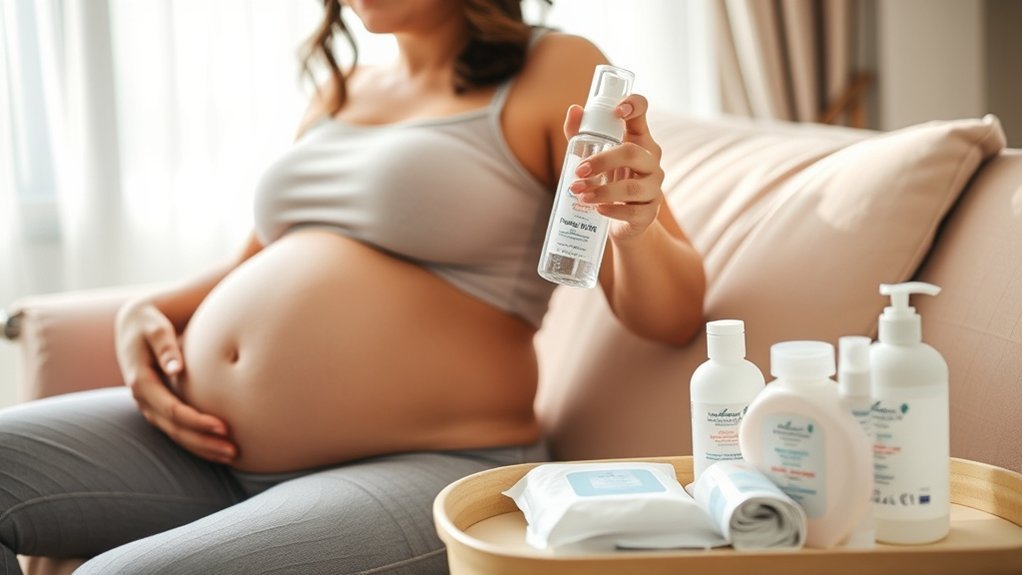Did you know that nearly 85% of women experience some form of perineal tearing during childbirth? As your body prepares for this significant event, understanding how to care for your perineum can greatly enhance your comfort and reduce the risk of injury. From perineal massage to exploring effective birthing positions, there are several strategies you can implement. Let’s explore these options to guarantee you feel informed and supported throughout your pregnancy journey.
Understanding the Perineum and Its Changes During Pregnancy
As your pregnancy progresses, you may notice various changes in your body, particularly in the perineum—the area between your vagina and anus.
In the third trimester, swelling and discomfort can occur due to hormonal changes and the growing baby’s pressure, preparing your body for childbirth. Stretching in this area is normal as your body readies itself for vaginal delivery, but it might lead to temporary soreness.
It’s important to note that approximately 40 to 85 percent of women experience perineal tears during childbirth. Understanding these changes can help you manage potential perineal trauma.
Engaging in perineal massage can enhance the elasticity of the perineum, possibly reducing the risk of tearing when you give birth.
The Benefits of Perineal Massage
Perineal massage offers numerous benefits as you approach childbirth, especially if you’re looking to minimize discomfort and complications during delivery.
Practicing perineal massage from around the 34th week of pregnancy can greatly reduce the risk of perineal trauma and the need for an episiotomy. Just 5 minutes a day can enhance the elasticity of your perineum, promoting a smoother vaginal delivery.
Studies show that consistent practice is associated with decreased rates of perineal injuries, pain during intercourse, and urinary incontinence post-delivery. Additionally, engaging in this technique can lead to improved postpartum recovery by minimizing scarring.
Many healthcare professionals endorse perineal massage, highlighting its importance in prenatal education and preparation for childbirth, ensuring you feel confident and informed. Furthermore, incorporating this practice into your routine can be part of the right screenings throughout your pregnancy to optimize your overall health.
How to Perform Perineal Massage
Starting perineal massage around the 34th week of pregnancy can be a valuable addition to your prenatal routine. This technique may help stretch the perineum and reduce the risk of tearing during childbirth.
To perform perineal massage, find a comfortable position, like lying down or seated. Use almond oil or a water-soluble lubricant for a smooth experience.
Insert your thumbs or 1-2 fingers about 3-5 cm into the vagina, applying gentle downward pressure toward the anus. Hold the stretch for up to 2 minutes, with each session lasting no more than 5 minutes.
Don’t forget to consult your healthcare provider for guidance and to ascertain this technique suits your specific circumstances, especially if you’re concerned about pain from perineal trauma. Additionally, consider that preeclampsia is a life-threatening disorder that can complicate pregnancy and may impact your perineal care decisions.
Additional Techniques for Perineal Protection During Birth

While preparing for childbirth, incorporating additional techniques for perineal protection can greatly enhance your birthing experience.
Using warm compresses on the perineal area during labor can help improve tissue elasticity and reduce the risk of tearing. You might also consider discussing favorable birth positions, like all-fours or side-lying, with your healthcare provider, as these can minimize perineal trauma.
Manual perineal protection techniques, performed by a professional during crowning, can further support your tissues and reduce the likelihood of injury.
Remember, emphasizing slow and controlled delivery is vital; rapid crowning can heighten the risk of pain and damage.
Resources and Support for Expecting Mothers
As you prepare for childbirth, it’s important to know that a wealth of resources and support is available to help you navigate perineal care. Healthcare professionals like midwives and physiotherapists provide personalized support, offering guidance on perineal massage techniques and exercises. Prenatal classes often cover essential topics, emphasizing patient autonomy in decision-making. Additionally, support networks, both online and in your community, enable you to connect with other expecting mothers, share experiences, and discuss managing perinatal discomfort. Seeking information on prenatal care and check-ups can further enhance your understanding and preparation for this important aspect of pregnancy.
| Resource Type | Description |
|---|---|
| Educational Materials | Brochures and animations on perineal care |
| Prenatal Classes | Workshops covering perineal health topics |
| Support Networks | Online forums and local groups for mothers |
| Healthcare Support | Access to professionals for personalized advice |
Frequently Asked Questions
How to Relieve Perineal Pain During Pregnancy?
To relieve perineal pain during pregnancy, apply warm compresses, practice perineal massage, engage in pelvic floor exercises, use a supportive cushion when sitting, and guarantee lubrication during intercourse to minimize discomfort and promote relaxation.
What to Use for Perineal Massage During Pregnancy?
Imagine you’re preparing for childbirth and want to ease the process. You can use vitamin E oil for perineal massage, making certain to apply it gently. Always consult your healthcare provider to verify it’s safe for you.
How to Soothe Perineal Pain?
To soothe perineal pain, apply ice packs for 10 to 20 minutes, use a donut cushion when sitting, maintain proper hygiene, and consider gentle perineal massage to promote healing and comfort.
Is a Perineal Massage Painful During Pregnancy?
A perineal massage isn’t usually painful, but you might feel slight stretching or burning. Using lubricants can ease discomfort. Start gently, listen to your body, and communicate with your healthcare provider about any significant pain.
Conclusion
To summarize, prioritizing perineal care during pregnancy can make an enormous difference in your comfort and confidence as you prepare for childbirth. By incorporating perineal massage and exploring additional protective techniques, you’re not just easing potential discomfort—you’re taking proactive steps to enhance your birth experience. Remember, you’re not alone on this journey; seek support and resources to empower yourself. Embrace this transformative time with knowledge and care, and you’ll pave the way for a smoother delivery.
